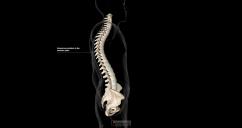Topic Resources
Kyphosis is an abnormal curving of the spine that causes a humpback.
The upper back normally curves forward somewhat. Some children
have a greater degree of curvature. The excessive curvature may be
-
Flexible
-
Fixed (structural)
In flexible kyphosis, children can straighten the spine by
tightening their muscles and the backbones (vertebrae) are normal. The
cause is not known. Muscle-strengthening exercises may help, but no
other specific treatment is needed.
In fixed kyphosis, children cannot straighten the spine
because several of the vertebrae in the upper back are wedge-shaped
rather than rectangular. Usually, 3 or more vertebrae are involved.
Rarely, infants are born with fixed kyphosis, but it more commonly
develops later in life, usually in adolescence. There are many rare
causes, including fractures, infections, and cancer, but the most common
cause is Scheuermann disease.
Kyphosis often causes no symptoms. Sometimes mild, persistent
back pain develops. Kyphosis may be noticed only because it alters the
body’s appearance. The shoulders may appear rounded. The upper spine may
appear more curved than normal, or a hump may be visible. Some people
have an appearance similar to those with Marfan syndrome, in whom the limbs are much longer than the trunk.
Mild kyphosis that does not cause symptoms is sometimes detected
only during a routine physical examination. A doctor may confirm the
diagnosis of kyphosis by taking x-rays of the spine.
Kyphosis: A Humpback
 |
Kyphosis

3D MODEL
Scheuermann Disease
(Scheuermann's Disease)
Scheuermann disease is the most common form of fixed kyphosis. It
usually begins in adolescence, affecting boys slightly more often than
girls. The cause of Scheuermann disease is unknown, but it sometimes
runs in families. Scoliosis, a sideways curvature of the spine, also often develops in children with kyphosis (called kyphoscoliosis).
Scheuermann disease is an osteochondrosis, which is a group of disorders of the growth plate of bones
that occur when the child is growing rapidly. Doctors are not sure what
causes osteochondrosis, but the disorders do seem to run in families. Osgood-Schlatter disease, Legg-Calvé-Perthes disease, and Köhler bone disease are other osteochondroses.
Severe kyphosis is more likely to cause discomfort and sometimes can restrict chest motion, causing lung disease.
Scheuermann disease may be discovered at school during a routine
screening for spinal problems. Doctors confirm the diagnosis of
Scheuermann disease by taking x-rays of the spine. Sometimes magnetic resonance imaging (MRI) or computed tomography (CT) is done.
Treatment
-
Reducing weight-bearing and strenuous activities
-
Rarely a brace or surgery
Mild kyphosis can be treated by reducing weight-bearing stress
and by avoiding strenuous activities. The spine may straighten slightly
with treatment, although symptoms may not lessen. It is unclear whether
treating mild kyphosis prevents the curve from worsening.
When kyphosis is more severe, treatment most often consists of
wearing a spinal brace or sleeping on a rigid bed. Treatment may lessen
symptoms and prevent the curve from worsening.
Rarely, despite treatment, kyphosis worsens to such an extent that surgery is needed to straighten the spine.











0 Comments